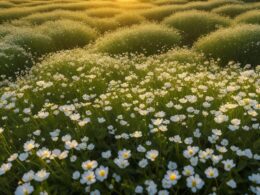When it comes to landscaping your garden, choosing the right ground cover can make a significant difference in both aesthetics and plant health. Two popular options for garden beds are mulch and pine straw. Both mulch and pine straw offer unique benefits and considerations to keep in mind when deciding which option is best for your landscape.
Mulch provides numerous benefits for your garden. Not only does it add a beautiful finishing touch to your flower beds, but it also acts as a moisture barrier, preventing water evaporation and helping to retain moisture for your plants. Additionally, mulch adds extra nutrients to the soil as it decomposes, promoting healthy plant growth.
On the other hand, pine straw offers its own advantages. It is a more cost-effective option compared to mulch, making it an attractive choice for larger landscaping projects. Pine straw is also relatively easy to spread and rearrange, allowing for simple maintenance and adjustments. Its natural look blends well with various garden styles.
However, there are considerations to keep in mind as well. While mulch provides long-lasting coverage, it can be more expensive and labor-intensive to spread compared to pine straw. On the other hand, pine straw needs to be refreshed more often and has the potential to add excessive acidity to the soil, which may not be suitable for all plants.
Ultimately, the decision between mulch and pine straw depends on factors such as longevity, cost, aesthetics, and the specific needs of your plants. Some homeowners even choose to incorporate both options into their landscape design, utilizing mulch in certain areas and pine straw in others.
By evaluating the benefits and considerations of mulch and pine straw, you can make an informed decision and create a beautiful and thriving landscape that suits your preferences and showcases the natural beauty of your garden.
Pros and Cons of Mulch
Mulch offers numerous benefits for your garden, making it a popular choice among gardeners. Understanding the pros and cons can help you determine if mulch is the right option for your landscape.
Moisture Barrier: One of the key advantages of mulch is its ability to provide a superior moisture barrier for plants. By retaining water and preventing evaporation, mulch helps to keep the soil consistently moist, reducing the frequency of watering.
Nutrient Provider: As mulch decomposes, it gradually releases essential nutrients into the soil. This natural process adds organic matter to enhance soil fertility, promoting healthier and more vigorous plant growth.
Weed Suppression: Another benefit of mulch is its ability to suppress weed growth. By acting as a protective layer, mulch prevents sunlight from reaching weed seeds, reducing their germination and growth.
Drawbacks: Despite the advantages, mulch does have some drawbacks to consider. Firstly, it is relatively more expensive than other options such as pine straw. Additionally, mulch may require more effort to spread evenly due to its heavier texture. It’s important to note that the quantity of mulch required can often be higher than expected. Obtaining a professional quote can help you determine the ideal amount for your specific needs.
When using mulch, it’s crucial to select the appropriate type for your garden, considering factors such as moisture retention, fertility requirements, and aesthetic appeal. Now that you understand the pros and cons of mulch, you can make an informed decision for your landscape.
Pros and Cons of Pine Straw
Pine straw is a popular choice for garden beds due to its affordability and ease of spreading. It can be a great option for areas with plantings that require acidic soil, such as azalea bushes. Pine straw also blends well with natural landscapes and can be a good choice for larger areas with pine trees.
One of the main advantages of using pine straw is its affordability. It is a cost-effective alternative to mulch, making it a budget-friendly option for homeowners. Additionally, pine straw is easy to spread and rearrange, allowing for flexibility in design and maintenance.
However, there are some downsides to using pine straw as well. One issue is that pine straw needs to be refreshed more often compared to mulch. Over time, pine straw breaks down and decomposes, losing its effectiveness as a ground cover. This requires more frequent clean-up and replacement to maintain the desired appearance and functionality of the garden bed.
Another consideration is that pine straw can potentially add too much acidity to the soil. While acidic soil is beneficial for certain plants, excessive acidity can be detrimental to others. It is important to monitor the pH levels and adjust the amount of pine straw accordingly to avoid creating an unfavorable environment for plant growth.
In addition, pine straw has a tendency to blow into other areas of the yard, requiring frequent clean up. This can be a nuisance for homeowners who want to maintain a tidy outdoor space. Regularly removing pine straw from unwanted areas becomes necessary to prevent it from smothering grass or accumulating around hardscape features.
- Pros of Pine Straw:
- Affordable option
- Easy to spread and rearrange
- Blends well with natural landscapes
- Cons of Pine Straw:
- Needs frequent refreshing
- Potential acidity issues
- Requires frequent clean up
Which is Better for Florida Landscaping: Mulch or Pine Straw?
When considering landscaping options in Florida, the choice between mulch and pine straw depends on several factors. Mulch offers better moisture retention and weed control, while pine straw provides a natural aesthetic and is easier to spread. To enhance your landscape, it’s also important to choose the best grass seed Florida suitable for the region’s climate.
Conclusion
In conclusion, when it comes to choosing between mulch and pine straw for your landscape, there are several factors to consider. Both options have their own advantages and disadvantages, so it ultimately depends on your specific needs and preferences.
Mulch is an excellent choice for front beds that require a fresh and well-maintained appearance. It not only provides a moisture barrier for plants, helping to retain water and prevent evaporation but also adds extra nutrients to the soil as it decomposes. However, it is important to note that mulch can be more expensive and requires more effort to spread.
On the other hand, pine straw is a more affordable option that is easy to spread and rearrange. It is particularly suitable for larger areas and landscapes that benefit from acidity, such as those with pine trees or plants that require acidic soil. However, pine straw needs to be refreshed more often than mulch and can potentially add too much acidity to the soil.
When making a decision, take into account factors such as longevity, cost, aesthetics, and the specific needs of your plants. If you’re unsure, consulting with a professional landscaper can provide expert advice tailored to your property. Ultimately, by considering all these factors, you can choose the best option for your landscape.









